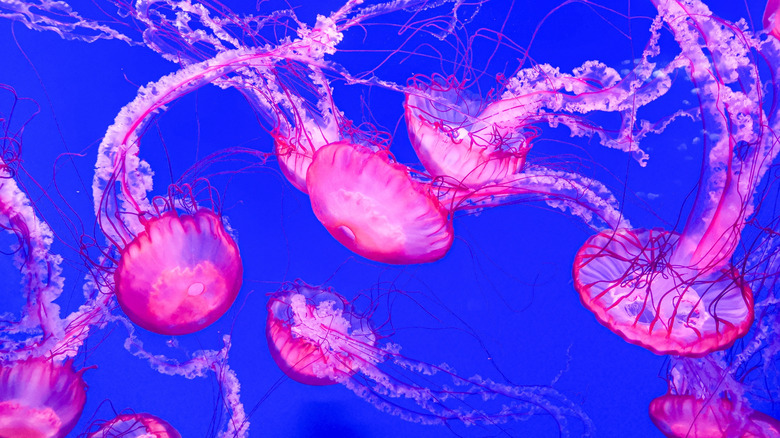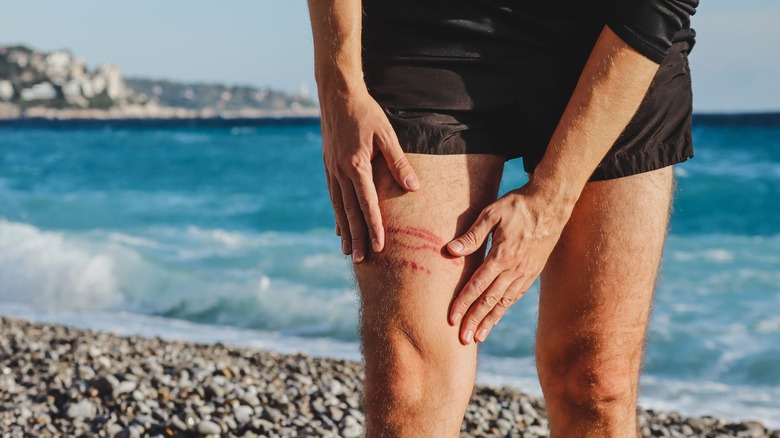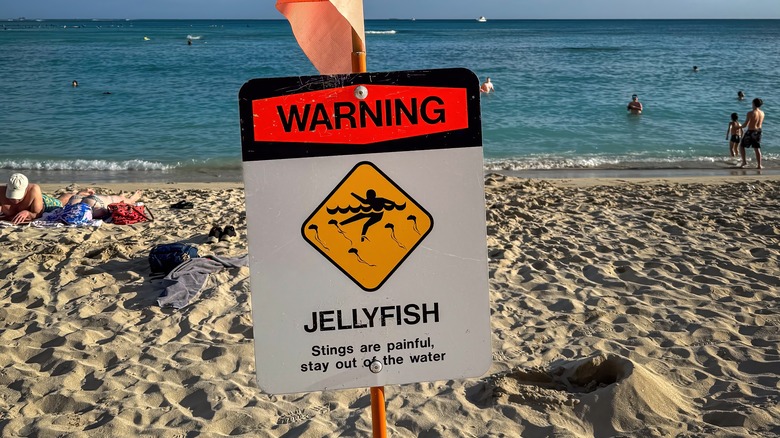Why You Should Never Pee On A Jellyfish Sting (And The Best Thing To Do Instead)
We may receive a commission on purchases made from links.
What is it about the beach that is so alluring? No other type of terrain attracts more vacationers than beautiful stretches of coastline — like these 50 best beaches in the world — so much so that we've come to equate a vacation with lounging on the sand while cooling off with a swim in the turquoise waters of the sea. Heading to the ocean has largely come to define what travel is, and while most anyone understands the joys and splendors offered up by a trip to the beach, there are also basic dangers that come with it.
People often underestimate the power and hidden hazards of the sea, such as rip currents and undertow, which makes drowning the number one concern. Look no further than this scenic California beach that has earned a chilling nickname for its dangerous reputation, and you'll see that even the most idyllic seaside spot must be approached with caution and respect.
This also goes for the animals that call the ocean home. Shark attacks — while exceedingly rare — do happen from time to time, and there are other creatures to steer clear of such as stingrays, sea snakes, and the extremely toxic lionfish. Jellyfish, however, pose the greatest danger to anyone who gets in the water, with some species delivering enough venom to prove lethal. If you do get stung, there are ways to treat the injury. However, despite what you may have heard, peeing on the wound is never a good idea.
Think before you pee on a jellyfish sting
We've all heard the advice that if you're stung by a jellyfish, the best immediate first aid is to urinate on the affected area. Where does this come from? Well, the idea stems from the notion that compounds found in urine, such as ammonia and urea, can help break down and unlodge the jellyfish stinging cells that are stuck in your skin.
However, peeing on a jellyfish sting won't likely make things any better. In fact, it could serve to worsen the pain, because the venomous barbs embedded in the skin react to external stimuli. This means that the power of the pee hitting the wound may cause the barbs to release even more venom, exacerbating an already painful situation.
Instead of perpetuating this unnecessary (not to mention unhygienic) urban myth, medical experts advise that you use seawater to gently remove any tentacles, as freshwater may cause them to fire off more venom. Any remaining barbs should be picked out with tweezers, or — if you don't have any on hand — gently scraped off with a credit card. Alcohol or vinegar can also be especially effective in treating the sting, and a hot shower or soak will also help ameliorate the pain, as heat may break down the venom. If you find yourself with chest pain, muscle cramps, difficulty breathing, nausea, or vomiting, seek medical attention immediately.
How to best avoid a jellyfish sting
There are over 3,000 species of jellyfish worldwide, making them a fact of life when swimming in the ocean. While many are harmless, others can cause serious injury or even death — like the box jellyfish — the most dangerous jellyfish you can encounter at the beach. However, despite the fact that jellys are found in waters in all corners of the globe, there are ways to decrease the likelihood of getting stung.
The most effective method is to wear tight, protective clothing that covers as much of your body as possible. These include stinger suits (available on Amazon), which will not just shield you from jellyfish, but also protect you from harmful UV rays. You can also rub petroleum jelly on any exposed parts of your body, such as your face and hands, or use a sunscreen such as Safe Sea from Amazon, which not only keeps you from getting burned, but also protects you from some jellyfish and sea lice stings.
It pays to know where jellyfish tend to group up, so you can avoid these areas. Jellyfish float with the currents, wind, and tide, so you're more likely to encounter them in bays or contained harbors than the open ocean. Also, talk with locals and other swimmers before heading into the water, as they're sure to know the jellyfish conditions at the time. And if there are any jellyfish warning flags flying at the beach, maybe limit your swimming to the hotel pool that day.


